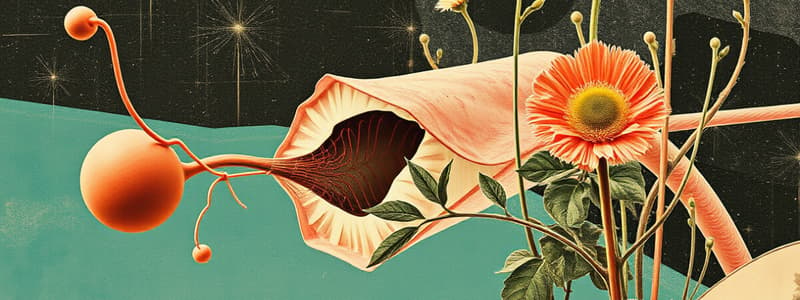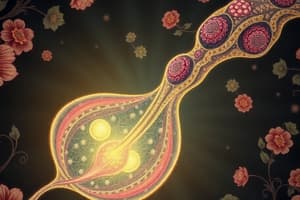Podcast
Questions and Answers
What is the significance of charophyceans in relation to land plants?
What is the significance of charophyceans in relation to land plants?
- They are the closest relatives to land plants among green algae. (correct)
- They are the primary consumers of terrestrial plants.
- They are the first multicellular organisms to inhabit land.
- They possess rosette cellulose-synthesizing complexes unique to land plants. (correct)
Which statement best describes the relationship between land plants and cyanobacteria?
Which statement best describes the relationship between land plants and cyanobacteria?
- Cyanobacteria are the direct ancestors of all land plants.
- The presence of cyanobacteria on land is the primary reason for the evolution of land plants.
- Cyanobacteria provided the initial photosynthetic capability for land plants.
- Cyanobacteria are significant but not the closest relatives of land plants. (correct)
Which feature is unique to both charophyceans and land plants compared to other algae?
Which feature is unique to both charophyceans and land plants compared to other algae?
- Presence of chlorophyll a and b.
- Ability to photosynthesize in terrestrial environments.
- Multicellular structure composed of eukaryotic cells.
- Cell walls containing higher percentages of cellulose. (correct)
What role do plant roots play in terrestrial ecosystems?
What role do plant roots play in terrestrial ecosystems?
What is the function of the peroxisome enzymes found in charophyceans and land plants?
What is the function of the peroxisome enzymes found in charophyceans and land plants?
How many years ago did plants, fungi, and animals begin to inhabit Earth?
How many years ago did plants, fungi, and animals begin to inhabit Earth?
Which of the following characteristics is shared by both plants and red algae?
Which of the following characteristics is shared by both plants and red algae?
Which of the following statements accurately describes the cellular structure of plants?
Which of the following statements accurately describes the cellular structure of plants?
What feature distinguishes the sperm of land plants from that of charophyceans?
What feature distinguishes the sperm of land plants from that of charophyceans?
Which process is a characteristic feature only found in land plants and certain charophycean algae during cytokinesis?
Which process is a characteristic feature only found in land plants and certain charophycean algae during cytokinesis?
What adaptation helps prevent exposed charophycean zygotes from drying out?
What adaptation helps prevent exposed charophycean zygotes from drying out?
Which of the following traits is NOT considered a derived trait of land plants?
Which of the following traits is NOT considered a derived trait of land plants?
What represents the multicellular stage that produces haploid cells in land plants?
What represents the multicellular stage that produces haploid cells in land plants?
Which term describes the growth regions at the tips of plant roots and shoots?
Which term describes the growth regions at the tips of plant roots and shoots?
What environmental factors favor the evolutionary adaptations seen in charophyceans?
What environmental factors favor the evolutionary adaptations seen in charophyceans?
Which of the following structures is responsible for producing protective walled spores in land plants?
Which of the following structures is responsible for producing protective walled spores in land plants?
What limits the life cycle of charophyceans compared to land plants?
What limits the life cycle of charophyceans compared to land plants?
What does the term 'alternation of generations' refer to in land plants?
What does the term 'alternation of generations' refer to in land plants?
What is produced by the mitotic division of a diploid zygote?
What is produced by the mitotic division of a diploid zygote?
Which structure is responsible for protecting developing spores until they are released?
Which structure is responsible for protecting developing spores until they are released?
What type of cell undergoes meiosis within sporangia to produce spores?
What type of cell undergoes meiosis within sporangia to produce spores?
What significant trait do land plants possess that differentiates them as embryophytes?
What significant trait do land plants possess that differentiates them as embryophytes?
What compound is responsible for making the walls of spores tough and resistant to environments?
What compound is responsible for making the walls of spores tough and resistant to environments?
Which of the following is NOT a feature of multicellular plant embryos?
Which of the following is NOT a feature of multicellular plant embryos?
What role do flavoids play in plants?
What role do flavoids play in plants?
Based on the information, what do land plants primarily rely on for their nutrient transfer to embryos?
Based on the information, what do land plants primarily rely on for their nutrient transfer to embryos?
How do plants achieve sporic reproduction?
How do plants achieve sporic reproduction?
What suggests that the common ancestor of living plants existed around 700 million years ago?
What suggests that the common ancestor of living plants existed around 700 million years ago?
Which of the following statements about bryophytes is accurate?
Which of the following statements about bryophytes is accurate?
What primary role do rhizoids play in bryophytes?
What primary role do rhizoids play in bryophytes?
Which of the following best describes the nature of the sporophyte in bryophytes?
Which of the following best describes the nature of the sporophyte in bryophytes?
What distinguishes gymnosperms from angiosperms?
What distinguishes gymnosperms from angiosperms?
Which phylum of bryophytes is characterized by the presence of liverworts?
Which phylum of bryophytes is characterized by the presence of liverworts?
What type of structures do gametophores produce in bryophytes?
What type of structures do gametophores produce in bryophytes?
Which of the following statements reflects a challenge in classifying bryophytes?
Which of the following statements reflects a challenge in classifying bryophytes?
Which characteristic is a unique adaptation of bryophytes after their evolutionary split from vascular plants?
Which characteristic is a unique adaptation of bryophytes after their evolutionary split from vascular plants?
What is the main function of the protonema in bryophytes?
What is the main function of the protonema in bryophytes?
What type of environment do modern seedless vascular plants predominantly thrive in?
What type of environment do modern seedless vascular plants predominantly thrive in?
What significant evolutionary trait differentiates vascular plants from bryophytes?
What significant evolutionary trait differentiates vascular plants from bryophytes?
Which component of vascular plant tissue is primarily responsible for transporting water?
Which component of vascular plant tissue is primarily responsible for transporting water?
How do roots contribute to the growth of vascular plants?
How do roots contribute to the growth of vascular plants?
What distinguishes microphylls from megaphylls in vascular plants?
What distinguishes microphylls from megaphylls in vascular plants?
What is the primary function of sporophylls in vascular plants?
What is the primary function of sporophylls in vascular plants?
Which feature of xylem cells allows vascular plants to achieve greater heights?
Which feature of xylem cells allows vascular plants to achieve greater heights?
What hypothesis explains the evolution of megaphylls in vascular plants?
What hypothesis explains the evolution of megaphylls in vascular plants?
What is a primary evolutionary trait that defines the life cycles of modern vascular plants?
What is a primary evolutionary trait that defines the life cycles of modern vascular plants?
What type of gametophyte do most seedless vascular plants develop from their spores?
What type of gametophyte do most seedless vascular plants develop from their spores?
Which of the following statements correctly describes heterosporous species?
Which of the following statements correctly describes heterosporous species?
Which of the following belongs to the phylum Lycophyta?
Which of the following belongs to the phylum Lycophyta?
What significant environmental change was caused by the first forests during the Carboniferous period?
What significant environmental change was caused by the first forests during the Carboniferous period?
Which plant is considered a 'living fossil' due to its primitive characteristics?
Which plant is considered a 'living fossil' due to its primitive characteristics?
During which geological period did ferns radiate extensively?
During which geological period did ferns radiate extensively?
What is the primary factor that led to the extinction of giant lycophytes?
What is the primary factor that led to the extinction of giant lycophytes?
How many species of living ferns are estimated to exist today?
How many species of living ferns are estimated to exist today?
What process led to the formation of coal during the Carboniferous period?
What process led to the formation of coal during the Carboniferous period?
Which plant group includes ferns, horsetails, and whisk ferns?
Which plant group includes ferns, horsetails, and whisk ferns?
What is the primary function of the foot in moss sporophytes?
What is the primary function of the foot in moss sporophytes?
Which part of the moss capsule is specialized for gradual spore release?
Which part of the moss capsule is specialized for gradual spore release?
What characteristic distinguishes hornwort sporophytes from liverwort sporophytes?
What characteristic distinguishes hornwort sporophytes from liverwort sporophytes?
How do vascular plants differ from bryophytes in terms of sporophyte complexity?
How do vascular plants differ from bryophytes in terms of sporophyte complexity?
What is the ecological role of phenolic compounds in moss cell walls?
What is the ecological role of phenolic compounds in moss cell walls?
Which of the following statements about Sphagnum is incorrect?
Which of the following statements about Sphagnum is incorrect?
What evolutionary significance do stomata in mosses and hornworts suggest?
What evolutionary significance do stomata in mosses and hornworts suggest?
Which plant group evolved first in terrestrial communities, according to the content?
Which plant group evolved first in terrestrial communities, according to the content?
What characteristic of peatlands contributes to their role as carbon reservoirs?
What characteristic of peatlands contributes to their role as carbon reservoirs?
Which statement about the anatomy of moss sporophytes is true?
Which statement about the anatomy of moss sporophytes is true?
Flashcards are hidden until you start studying
Study Notes
Earth’s Early History and Plant Evolution
- For the first 3 billion years, Earth had no land life; cyanobacteria appeared about 1.2 billion years ago.
- Approximately 500 million years ago, plants, fungi, and animals emerged on land.
- Current plant diversity includes over 290,000 species, primarily in terrestrial environments like deserts, grasslands, and forests.
Land Plants and Their Evolution
- Land plants evolved from green algae, specifically charophyceans, which are their closest relatives.
- Key characteristics such as multicellularity and the presence of chlorophyll a and b are shared with various algae.
- Unique features connecting charophyceans and land plants include specialized cellulose-synthesizing complexes in plasma membranes, specific peroxisome enzymes, structural similarities in sperm cells, and a distinct cytokinesis process.
Adaptations in Land Plants
- Land plants developed adaptations for survival on land, differentiating them from algae.
- Five key derived traits of land plants include:
- Apical meristems for growth at tips of roots and shoots, maximizing resource exposure.
- Alternation of generations featuring both gametophyte (haploid) and sporophyte (diploid) life stages.
- Multicellular embryos dependent on the parent for nutrients.
- Sporangia that produce hardy, walled spores.
- Gametangia for gamete production.
Life Cycle of Bryophytes
- Bryophytes consist of liverworts (Hepatophyta), hornworts (Anthocerophyta), and mosses (Bryophyta).
- In bryophytes, the gametophyte is the dominant life stage, while sporophytes are smaller and dependent on gametophytes.
- Bryophytes reproduce via specialized structures called gametophores that produce gametes; fertilization occurs in the presence of water.
Vascular Plant Characteristics
- Ferns and seedless vascular plants thrived during the Carboniferous period, preceded by bryophytes as the dominant flora.
- Vascular plants exhibit several characteristics:
- Dominant sporophyte lifecycle stage.
- Vascular tissues (xylem for water/mineral transport; phloem for nutrient transport).
- Evolution of roots that anchor plants and facilitate nutrient uptake.
- Emergence of leaves and specialized reproductive structures called sporophylls.
Importance of Bryophytes and Vascular Plants
- Bryophytes contribute significantly to ecosystems by dispersing spores widely and thriving in diverse habitats.
- Peat moss (Sphagnum) forms peat bogs, which play essential roles as carbon reservoirs and in nutrient cycling.
- Vascular plants allowed terrestrial ecosystems to evolve by maximizing light and nutrient absorption due to structural adaptations, leading to taller growth and increased biodiversity in forests.### Evolution of Roots
- Roots may have evolved from stem portions in ancient vascular plants.
- Uncertainty exists whether roots originated from a common ancestor of all vascular plants or developed independently.
- Investigating genes controlling root development can clarify this evolutionary debate.
Evolution of Leaves
- Leaves enhance surface area for photosynthesis by capturing solar energy.
- Classified into microphylls and megaphylls based on size and complexity.
- Microphylls are small leaves in lycophytes with a single unbranched vein, likely evolving from stem outgrowths.
- Megaphylls have a branched vascular system, allowing greater water, mineral transport, and sugar export.
- Fossils suggest megaphylls arose from closely spaced branches on a stem, possibly flattening with webbing tissue.
Sporophylls and Spore Variations
- Sporophylls are modified structures bearing sporangia, varying widely in form.
- Ferns form sori, clusters of sporangia on leaf undersides; gymnosperms produce cone-forming sporophylls.
- Species distinctions include homosporous (one spore type) and heterosporous (two spore types).
- Most seedless vascular plants are homosporous, developing bisexual gametophytes, while seed plants and some others are heterosporous.
Classification of Seedless Vascular Plants
- Major clades: lycophytes (club mosses, spike mosses, quillworts) and pterophytes (ferns, horsetails, whisk ferns).
Phylum Lycophyta:
- Lycophytes are remnant species from the Carboniferous, which had both small and giant tree forms.
- Giant lycophytes, reaching heights of 40 meters, went extinct due to climatic changes.
- Presently, about 1,200 species of small lycophytes exist.
Phylum Pterophyta:
- Ferns diversified significantly from their Devonian origins and thrived in Carboniferous swamp forests, with 12,000 living species today.
- They are most abundant in tropical climates and can adapt to temperate forests and arid regions.
- Historical horsetails reached heights of 15 meters; today, only 15 species exist within genus Equisetum.
- Whisk ferns are unique as they possess neither true roots nor leaves and exhibit dichotomous branching, linking them to early vascular plants.
Significance of Seedless Vascular Plants
- Ancestors of lycophytes and ferns created the first forests during the Carboniferous era.
- Evolution of vascular tissue, roots, and leaves increased photosynthetic rates and CO2 removal from the atmosphere.
- CO2 levels were estimated to drop significantly, leading to global cooling and glacier formation.
- First forests contributed to the formation of modern coal through the conversion of peat under pressure over millions of years.
- Humans continue to utilize coal, burning approximately 6 billion tons annually.
Studying That Suits You
Use AI to generate personalized quizzes and flashcards to suit your learning preferences.




